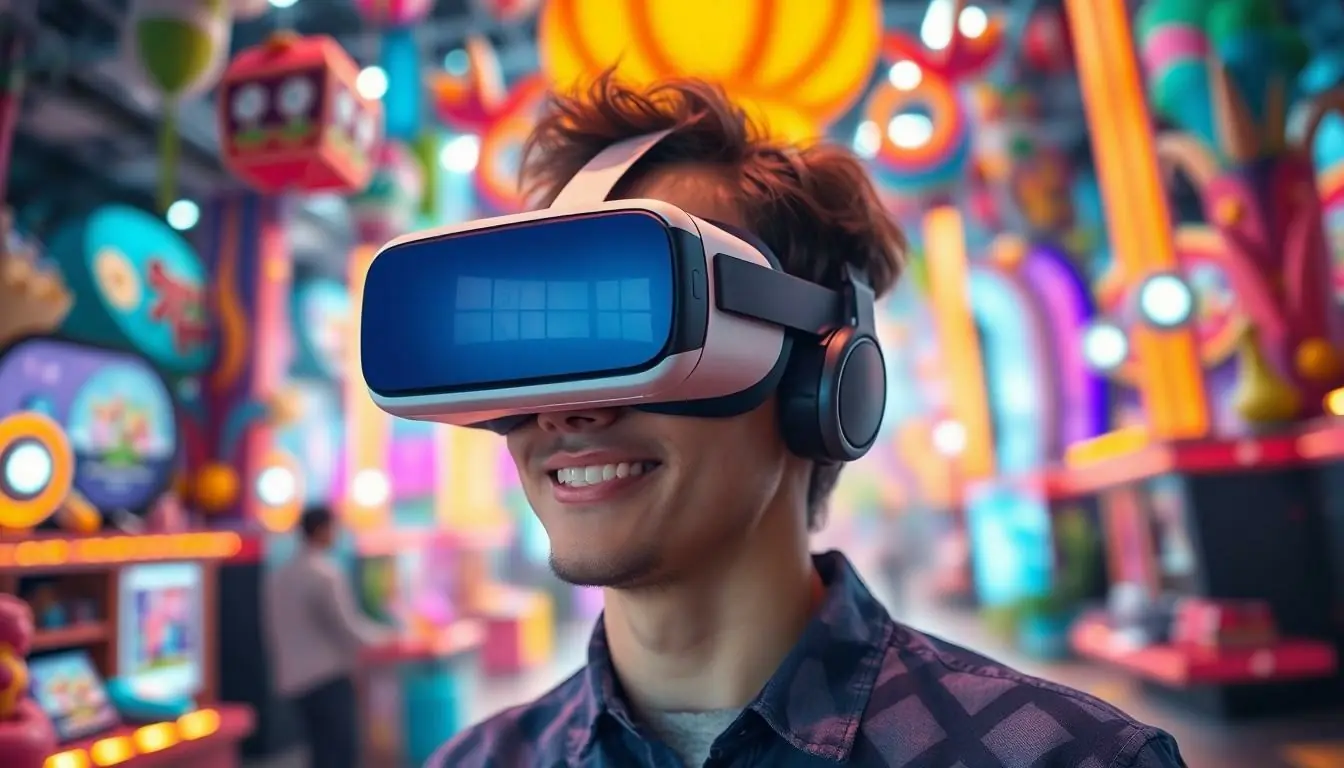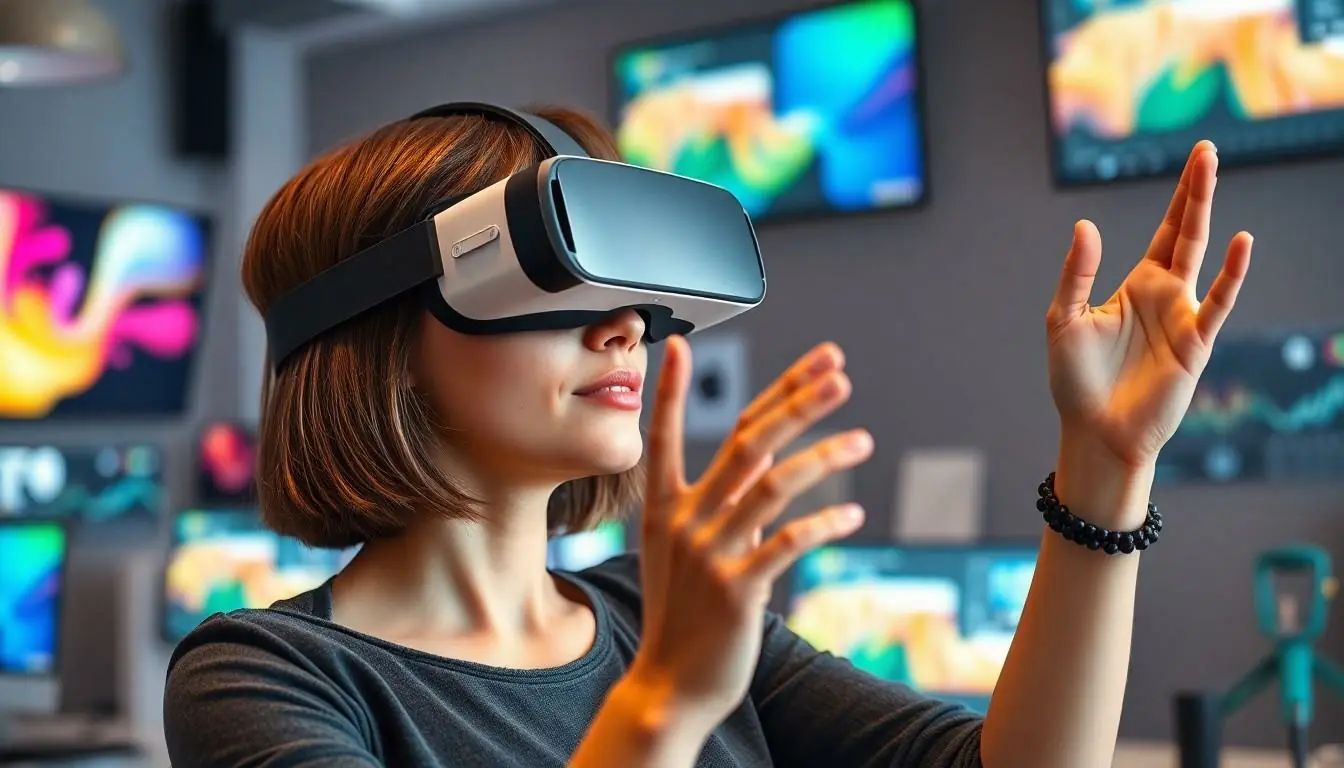Imagine stepping into a world where the only limit is your imagination. Virtual reality design isn’t just about creating stunning graphics; it’s about crafting immersive experiences that transport users to places they’ve only dreamed of. From gaming adventures that make you feel like a hero to training simulations that prepare professionals for real-world challenges, the possibilities are endless.
Table of Contents
ToggleOverview of Virtual Reality Design
Virtual reality design encompasses creating immersive experiences that engage users in interactive environments. Immersive worlds invite users to explore and interact, significantly enhancing their overall experience. Designers focus on crafting sensory-rich environments, integrating visuals, audio, and haptic feedback to elevate immersion.
Various applications for virtual reality design emphasize its versatility. Gaming remains a primary sector where designers create captivating adventures that transport users into fantasy realms. In enterprises, training simulations utilize virtual reality to prepare professionals for scenarios they will face in their careers. Architects and engineers use virtual reality to visualize spaces, allowing clients to experience plans before execution.
Collaboration plays a crucial role in virtual reality design. Designers often work with developers, artists, and sound engineers to deliver cohesive projects. They ensure that every element contributes to the overall experience, making virtual interactions feel authentic.
Technology advancements fuel innovations in virtual reality design. New hardware and software tools enhance capabilities, offering designers greater freedom and flexibility. As the industry evolves, so do the possibilities for creating more engaging and meaningful experiences.
Effective virtual reality design blends creativity with technical skills. Understanding user behavior and expectations helps designers craft experiences that resonate with audiences. By prioritizing user experience, they can ensure that interactions are not just visually appealing but also emotionally engaging.
This ever-expanding field continues to grow, and designers remain at the forefront, leveraging technology to create stunning virtual experiences that captivate users worldwide.
Key Principles of Virtual Reality Design

Effective virtual reality design hinges on several key principles that enhance user experiences. Designers focus on creating environments that engage all senses, maximizing immersion and interactivity.
Immersion and Presence
Creating a strong sense of immersion is essential for captivating users in virtual reality. Designers prioritize realistic audio, lifelike visuals, and responsive environments that simulate real-world physics. In doing so, users feel a genuine presence within the virtual space. Techniques like 3D modeling and spatial audio reinforce this immersion, making interactions believable. Elements such as realistic lighting and texture further enhance the user experience. Engaging users emotionally also strengthens the sensation of being part of the virtual world, leading to deeper connections with content and environments.
Interactivity and Usability
Promoting interactivity and usability forms the backbone of an engaging virtual reality experience. Designers emphasize intuitive controls that encourage exploration and interaction. Clear navigation options enable users to move confidently within spaces, reducing frustration. Feedback mechanisms, such as visual cues and haptic responses, provide users with immediate reactions to their actions, enriching the experience. Creating diverse interaction types, from simple gestures to complex tasks, allows users to explore various possibilities. Overall, seamless usability ensures that users remain focused on immersive experiences rather than grappling with technical barriers.
Tools and Technologies in Virtual Reality Design
Various tools and technologies play vital roles in virtual reality design, enhancing creative possibilities and user experiences.
Software Applications
Numerous software applications facilitate the development of virtual reality experiences. Unity and Unreal Engine represent popular platforms for designers due to their robust features and customization capabilities. Both allow for high-quality graphics and seamless integration of interactive elements. Additionally, Blender offers 3D modeling tools, enabling creators to develop unique assets for virtual environments. Other applications like SketchUp assist in architectural visualization, making it easier to design realistic spaces. Collectively, these software applications provide a solid foundation for delivering immersive experiences.
Hardware Considerations
Selecting appropriate hardware significantly impacts virtual reality design. High-quality headsets such as Oculus Quest 2, HTC Vive, and Valve Index provide immersive visuals and sound. Each headset caters to different budgets and preferences, offering unique features that enhance user experiences. Controllers and tracking systems require consideration as well, with options like motion controllers enabling users to interact naturally. Graphics processing units (GPUs) also play a crucial role in processing high-quality graphics, influencing overall performance. Prioritizing the right hardware ensures an engaging and seamless virtual reality experience.
Best Practices for Effective Virtual Reality Design
Effective virtual reality design hinges on several best practices that prioritize user immersion. First, ensure that environments engage all senses. This includes using realistic audio, lifelike visuals, and responsive elements that mimic real-world physics.
Utilizing intuitive controls enhances user interaction. Developers should focus on clear navigation to guide users effortlessly through experiences. Immediate feedback mechanisms also play a crucial role in ensuring users feel connected to their actions.
Consider emotional engagement as a core element. By designing experiences that resonate with users, designers foster stronger connections with virtual worlds. Users often remember experiences that evoke emotions, making this an essential strategy in design.
Advancements in technology should inform design choices. Staying updated on the latest tools and hardware helps create more captivating experiences. High-quality headsets and motion controllers are vital for delivering seamless interactions.
Collaboration among team members is paramount. Designers, developers, and sound engineers must work together to create cohesive experiences. This teamwork enhances the overall quality of virtual environments.
User testing must be a fundamental part of the design process. Gathering feedback enables designers to refine interactions and improve usability. Iteration based on user input produces more effective designs.
Lastly, maintaining a focus on accessibility ensures broad reach. Adapting experiences for various users, including those with disabilities, broadens audience engagement. Comprehensive strategies combine creativity with technology to facilitate unforgettable virtual reality experiences.
Future Trends in Virtual Reality Design
Cutting-edge technology shapes future trends in virtual reality design. Increased adoption of artificial intelligence enables more adaptive environments. Users experience tailored interactions that respond to their preferences and behaviors. Enhanced realism is achievable with improved graphics and processing power, creating visually stunning virtual worlds.
Collaboration between virtual reality and augmented reality is on the rise. Mixed reality environments offer seamless integration of digital elements with the physical world. Developers create applications that enhance real-life experiences, enriching both journeys and tasks.
Social experiences in virtual reality are gaining prominence. Virtual spaces allow users to connect, communicate, and collaborate in engaging ways. Communities form around shared experiences, transforming how people interact in digital realms.
Accessibility in virtual reality design is crucial. Designing for diverse audiences ensures everyone can partake in virtual experiences. Incorporating features like voice commands and customizable options enhances usability for all.
Sustainability will play a significant role in future virtual reality projects. Designers will focus on environmentally friendly practices, using sustainable resources and energy-efficient technologies. This commitment reflects a growing trend towards responsible design and production methods.
Finally, immersive storytelling continues to evolve. Creators experiment with narrative techniques that deepen emotional engagement. Engaging plotlines interwoven with interactive elements captivate users, fostering lasting connections to virtual experiences.
Virtual reality design stands at the forefront of innovation by merging creativity with technology. As designers embrace new tools and techniques they’re reshaping user experiences across various sectors. The emphasis on emotional engagement and sensory immersion is vital for creating memorable interactions.
Future developments promise even more exciting possibilities with advancements like artificial intelligence and mixed reality. These trends will not only enhance user engagement but also foster community and collaboration in virtual spaces.
By prioritizing accessibility and sustainability designers can ensure that virtual reality experiences resonate with diverse audiences. Ultimately the evolution of this field will continue to push boundaries and redefine how users connect with digital environments.

